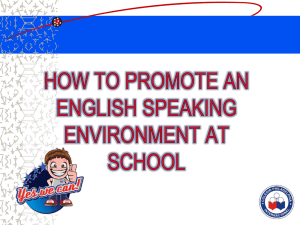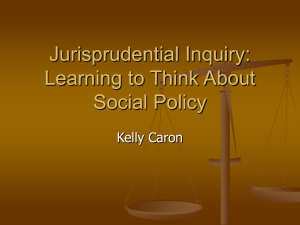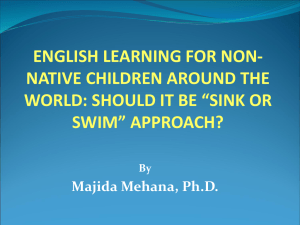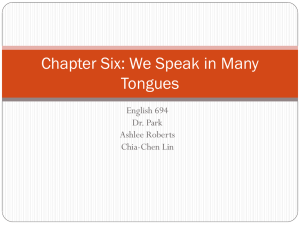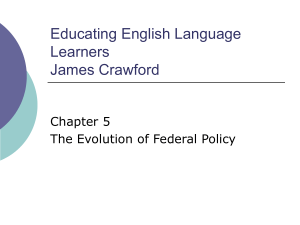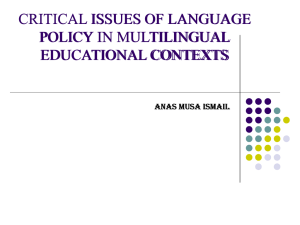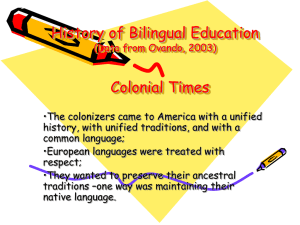Changes in Classroom Literacy Practices - A Research
advertisement
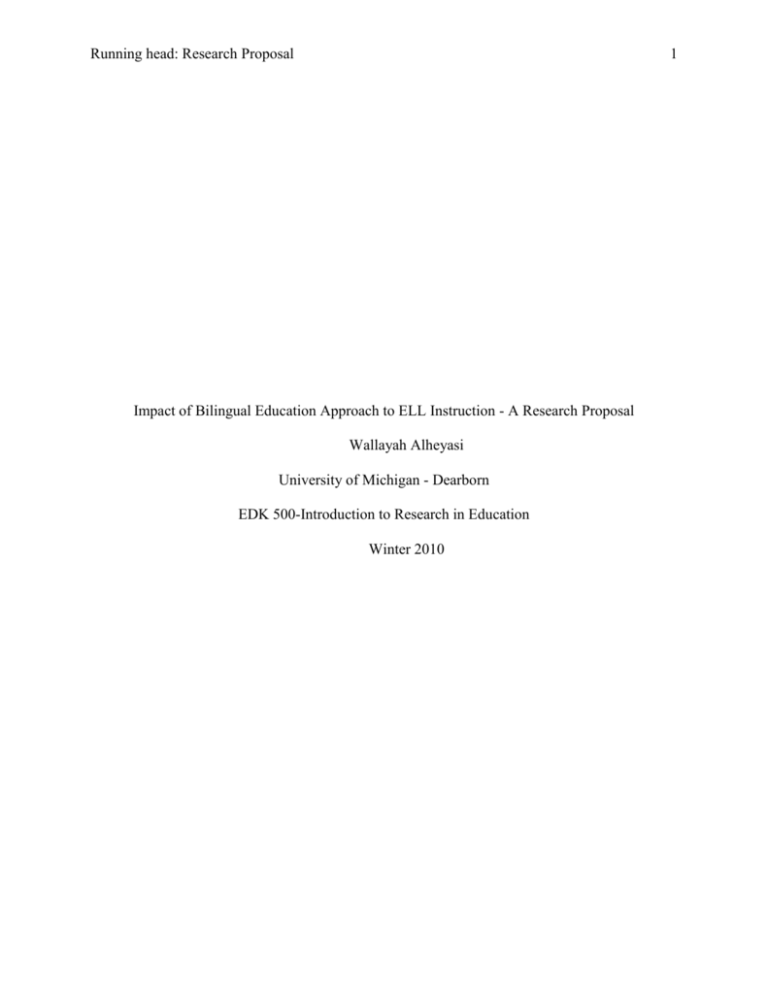
Running head: Research Proposal 1 Impact of Bilingual Education Approach to ELL Instruction - A Research Proposal Wallayah Alheyasi University of Michigan - Dearborn EDK 500-Introduction to Research in Education Winter 2010 Research Proposal 2 Abstract This paper will explore the effects of two-way bilingual education. If taught effectively and resources are available, bilingual students will benefit more significantly from a dual language program. Research participants would include three classes, sixth through eighth graders in social studies and language arts. Participants would also include the mainstream teachers that are impacted, sixth through eighth grade and the other bilingual newcomer teachers that instruct the other subjects, math, science, and technology. Administration and other staff input will be included. A consent form is needed because the district requires that for any sort of survey or study performed with students. The type of consent form used is the “Statement of What the Study Will Ask the Participant to Do or Have Done to Him/Her.” This method will be used because students will need to be questioned as well as their parents. For the sake of accountability, the consent forms will be requested back whether or not the student will be participating. The portion of the form that needs to be returned will be translated in the students’ native language which is Arabic in this case. Only questions need to be prepared in the form of surveys to collect the data and the consent forms. Since most of the information is accessible such as assessment scores, additional instruments may not be needed. To gather the information necessary, assessment scores such as DRA (Developmental Reading Assessment), MEAP scores, grades and other relevant scores will be collected in order to analyze the progress and effectiveness of the program. Keywords: two-way bilingual education, newcomers, ELLs, ESL, bilingualism, multilingualism, sheltered classroom, English immersion programs, native language development. Research Proposal 3 Introduction The research topic of this proposal is on the progress and academics of newcomers or English language learners (Ells) in the transitional or mainstream class as a result from instruction given and impact of education from a sheltered class also known as two-way bilingual education, and in this case, called “The Newcomer Center.” As and educator of sixth, seventh, and eighth grade newcomers, language arts and social studies, the impact of the twoway bilingual education approach to ELL instruction will be studied. Is it the most effective way to transitioning students into mainstream/general education classes? How successful and what is the impact or need of two-way bilingual education otherwise known as the Newcomer Center in the middle school? Since this program was put into effect four years ago, some students have been achieving at high standards and even on honor roll, yet some have not been doing well or even failing their transitional mainstream classes. Some students are failing to effectively communicate in class, going through yet another culture shock in their new environment, or end up needing to come back to the Newcomer Center. There is also an elementary Newcomer Center for fourth and fifth graders mixed in the same classroom but it is run according to the mainstream elementary classes except that the students’ main native language is also used to instruct. There are many different student characteristics that are faced such as students coming to the classroom with zero education or schooling, learning disabilities, or little or no background knowledge. Because of certain rules or laws, newcomers are not tested for learning disabilities due to the language barrier which presents another major issue. Ultimately, I believe that there are more dynamics involved and individual situations that are beyond the control of newcomer teachers that affect the progress and academics of some of the students transitioned. Research Proposal 4 Some issues presented are that the grades are mixed in the classroom. Depending on the number of students enrolled for the school year, that is how the classroom is organized. The program itself is “work in progress.” For example, the first year I taught, I had taken over at the end of the year and all my sessions were a mix of sixth through eighth grades and I was teaching both language arts and social studies in a block of two hours. It was overwhelming to say the least. The second and third year or teaching, I suggested at least separating one of the grades and so we had sixth and seventh grades together and eighth graders in their own class setting. Due to numbers, the sixth graders are in one classroom and there is a mix of seventh and eighth graders in another. It definitely is working out better but ultimately it would be very practical and much more effective if we could have each grade separated and a teacher for each of the subjects. If there was enough funding, I am confident that the program would be even more effective and successful. More time is needed to evaluate and research better solutions to the issues that exist but until then, I do believe that the program is effective and benefitting all teachers involved more so than if it did not exist. It is also benefitting the students, parents, and administration. Research Proposal 5 Literature Review One of the articles stressed that “creating a classroom "community" can empower English language learners during elementary school and beyond” (Whitmore, 2005/2006). Some of the studies were to find out if the dynamics of the bilingual classroom had any lasting impact on the lives of the students as English language learners. Analysis indicated that students were able to thrive and succeed in a classroom where shared power existed, where highly intellectual and authentic academic work was present, and where bilingualism and biliteracy were regarded as valuable resources. It was clear to them 10 years later that the “students carried the power and responsibility for learning they acquired as third graders with them into other classroom settings and into their communities” (Whitmore & Crowell, 2005/2006). Another literature review discusses starting a two-way bilingual program, implementing effective instruction, and involving teachers and parents in the process. The author “examines the various theoretical models and associated research, presents criteria that define TWB programs, and provides the rationale for program implementation” (Brown, 2004). It supported the twoway bilingual programs that help students “foster language equity and equalizes the opportunities” for each of those students and “respects and treats all students as equal members of the school community and challenges students and staff to do their best regardless of race, national origin, education, language, and culture” (Brown, 2004). “Many middle school language arts teachers are not familiar with the theories and practices of bilingual education programs. Teachers, class environment, type of school, and area they live in can have adverse effects on the futures of certain children” (Lopez & Tashakkori, 2006). The article discussed “how middle school language arts teachers can better address the needs of middle school English language learners who no longer receive formal language Research Proposal 6 support, as well as about ways to provide them with classroom environments that can support their learning and bring out knowledge and abilities that they, like all young people entering middle school, have to offer.” Two-way bilingual education, bilingualism, biliteracy, and newcomer center programs are just a few ways that identify programs that assist bilingual students acquire language proficiency and be able to succeed in their transitional mainstream classes. There are many advocates for these types of curriculums that have positive effects on students and those involved in the process. It is necessary to provide research-based guidance due to the increase of language-minority students. Two-way bilingual education programs have a significant impact to Ell instruction and are truly beneficial to the progress, academics, and success of newcomers or English language learner students and their transitioning to mainstream classes in the middle school. Research Proposal 7 Method My research participants would include my three classes, sixth through eighth graders. I would not have to recruit them because I teach them daily for two subjects, language arts and social studies. My participants would also include the mainstream teachers that are impacted, sixth through eighth grade and the other bilingual newcomer teachers that instruct the other subjects, math, science, and technology. Also, I may possibly seek the principal’s input. I would need a consent form because our school requires that for any sort of survey or study done with students. The type of consent form I would use is the “Statement of What the Study Will Ask the Participant to Do or Have Done to Him/Her.” I would use that method because I might need to ask the students a few questions and possibly the parents about what their opinions are, as well. It would be easier to send home a consent form and only expect it back if the parents do not want their child to participate in the research. I would only need to have questions prepared to collect the data and the consent forms. Since most of the information is accessible to me such as assessment scores, I do not think I will need other instruments. Mainly, I would use assessment scores such as DRA (Developmental Reading Assessment) and grades to see what the progress is. I could use a survey form for the parents, students, and teachers if there is a time constraint and am unable to interview in person. E-mailing teachers and the principal involved would be the quickest way to gather the results. Students can be given a simple survey in class and one sent to their parents. I think this would be the most efficient way and using a survey rather than verbally questioning the students at once will keep confidentiality. Research Proposal 8 An in-person interview will be conducted with each teacher individually with the interviewer. I believe this method of collecting data is very effective to the research because the researcher can use prompts and probe the teacher to get more detailed information and understand more about the issues at hand dealing with bilingual education in the building. The participants will be all teachers who have transitional students coming from the Newcomer Centers/bilingual education program in the selected school. It is important to acquire this information because we need to know how successful the students are and if not, what are some solutions to improving the program or aiding the students that are having difficulties. The questions can be directed during staff meetings, preps, or a convenient time for the interviewees. The time required will be as much time needed to answer the questions, but no more than 30 minutes for each session. To discuss validity and reliability in my proposal of studying the effects of two-way bilingual education, I will need established instruments. Assessment scores gathered from their cumulative files will be used, as well as, MEAP scores, their DRA which is their Development Reading Assessment scores, grades from my language arts and social studies courses, and grades from their other core classes. Any other relevant scores will be useful, too. I believe that the assessment scores collected are reliable for the most part but not valid. Inter-rater reliability would be my concern because using the DRA to test is very subjective and that is been an issue in our building, as well as district. We may be off by a few reading levels but can be reliable because it is very close to assessing the students’ reading levels. Some teachers may score more rigidly than others and thus making the instrument reliable but not very accurate. Research Proposal 9 Discussion This research is extremely important and the findings are very crucial to improving the Newcomer Center/two-way bilingual program. Conducting a few practice interviews and using the survey and questionnaire before actually initiating the research will be beneficial. Since the program has been in effect for a few years, suggestions and recommendations will result from the research in order to have more improvements. This study is much more formal and gives the research as back up to decisions about making more modifications. Through the research, the suggestions, comments, and recommendations for improvements will be coming from students, staff, and parents, as well, as opposed to just from the instructor. Although students still may still struggle and not do well, or fail their mainstream transitional classes, there are those that are achieving at high levels which proves that the Newcomer Center program is a benefit and that research will help improve it. Two-way bilingual education can be successful if it is conducted effectively and it is crucial and necessary in order to prepare students to acquire language proficiency and prepare English language learners to success in transitional mainstream classes. The research will benefit to evaluate the Newcomer Center program to better student learning. Albert Einstein once said, “It is, in fact, nothing short of a miracle that the modern methods of instruction have not entirely strangled the holy curiosity of inquiry.” Research Proposal 10 References Brown, Julie Esparza. Designing and Implementing Two-Way Bilingual Programs: A Step-byStep Guide for Administrators, Teachers, and Parents. (Fall, 2004). Bilingual Research Journal. Vol. 28, Iss. 3; pg 485, 5 pgs. Cuero, K. K., Dworin, J.E., Lowery, R., & Fink, L.S. (2007). Lessons from Jeniffer: Addressing Common Assumptions Regarding “Former” English Language Learners. Voices From the Middle. Urbana, 14, 15-25. Lopez, Maria G. & Tashakkori, Abbas. (Spring, 2006). Differential Outcomes of Two Bilingual Education Programs on English Language Learners. Bilingual Research Journal. Vol. 30, Iss. 1; pg. 123, 24 pgs. Ramos, Francisco. (2007). What Do Parents Think of Two-Way Bilingual Education? An Analysis of Responses. Journal of Latinos and Education. Vol. 6, Iss. 2; pg. 139. Whitmore, K. F., & Crowell, C.G. (2005, Dec/2006, Jan). Bilingual education students reflect on their language education: Reinventing a classroom 10 years later. Journal of Adolescent & Adult Literacy, 49, 270-285. Research Proposal 11 APPENDIX A Impact of Bilingual Education/Newcomer Center Survey Dear Staff Members, Please answer the following questions in order for us to better improve the newcomer center/bilingual education program. Your input is invaluable and appreciated. Thank you in advance! 1. What subject(s) do you teach? 2. What grade(s) do you teach? Check all that apply. 6th 7th 8th 3. Do you feel that the transitional students that come to you are well prepared? Yes. No. 4. How would you rate the overall effectiveness of the newcomer center/bilingual education program? 1 2 3 4 5 6 Very Effective Not Effective At All 5. Please rate the following statements. Very Strongly Strongly Disagree Disagree a. The newcomer center/bilingual education program makes my job easier. b. Having the newcomer center does not affect me either way. Agree Strongly Agree Very Strongly Agree Research Proposal 12 6. What are some of the reasons you think some transitional students are NOT progressing in the mainstream classes? 7. Do you have any suggestions for improving the program? (Examples being how to better prepare the students, supplemental material suggestions, etc.) 8. What resources are available to help you work with transitional students? Choose one response please. I have all the resources needed.---->Please skip the next question. I have some resources that are needed. ---->Go to the next question. I have none of the resources I need. ---->Go to the next question. 9. Please explain why you do not have enough or any resources. 10. What opinions or comments do you have regarding the newcomer center/bilingual education? (Any input would greatly be appreciated. Thank you for completing this survey. APPENDIX B Research Proposal 13 Focus Group Questions Impact of Bilingual Education/Newcomer Center (Moderator reads bolded script.) As teachers of transitional students, you work daily to improve instruction to meet the needs of our English Language Learners. I would like to ask you some questions about the impact of the instruction and preparation given to our newcomers who enter your classrooms. I will be tape-recording the session today so that I can remember everything that is discussed. I may also make written notes. Please think about the classrooms in which you work when you respond to these questions. I will allow everyone to respond before moving to the next question. 1. There has been a considerable amount of conflict taking place regarding the Newcomer Centers and students transitioning into your classrooms. What do you believe are the cause of those conflicts and what is your opinion regarding the issues? Are there any other issues? 2. If you had more support in the classroom or had a specific section for transitional students, would that remedy one of the problems? What else can be done to alleviate some of the conflicts? 3. In your opinion, do you believe that the students should remain in the Newcomer Center and not be transitioned at all during their middle school years? Why do you feel that way? 4. What other comments or suggestions do you have regarding the bilingual education program and what would you like to change? (Moderator) Thank you for attending this focus group and speaking with me today. Your answers will help us determine how we can improve our bilingual education program, as well as give us additional information for collaborating more with you in the future. APPENDIX C Research Proposal 14 Consent to Participate in Research Impact of Bilingual Education Dear Parent or Legal Guardian: I, Mrs. Alheyasi, am attending the University of Michigan this semester and am conducting a research study for one of my courses. Your child is being asked to be a part in this research and will only be asked a few questions. This is a very important survey that will help me find out the best and most effective way of transitioning your child into mainstream classes and finding ways to improve our current program. Please read this form for information about the survey and for instructions on how to withdraw your child. Survey Content. The survey gathers information on developmental supports provided to youth; school connectedness and barriers to learning, as well as behaviors. I may also be asking for your input. The results from this survey may only be shared with the University of Michigan and staff at Salina Intermediate. It is Voluntary. Your child does not have to take the survey. Students who participate only have to answer the questions they want to answer and they may stop taking it at any time. It is Anonymous. No names will be recorded or attached to the survey forms or data. The results will be made available for analysis. Administration. The survey will be administered during this school year. It will take about 5 to 10 minutes and will be administered in your child’s Language Arts/Social Studies class. For Further Information. Please do not hesitate to call me at Salina Intermediate if you have any questions or concerns at: (313) 827- 6600. Please return the bottom portion of the form. Your cooperation is appreciated. -------------------------------------------------------------------------------------------------------------------- No, I do not give permission for my child to participate. Yes, I give permission for my child to participate. My child’s name is: Parent Signature: __________________ ٠ ال أسمح لولدي بالمشاركه٬كال ٠ أسمح لولدي بالمشاركه،نعم _____ Grade:______ _____ Date: ______

